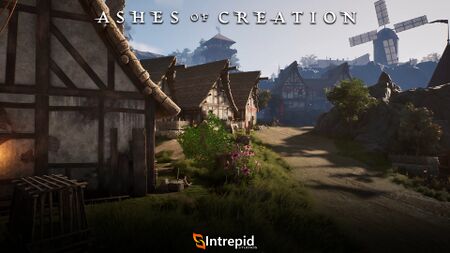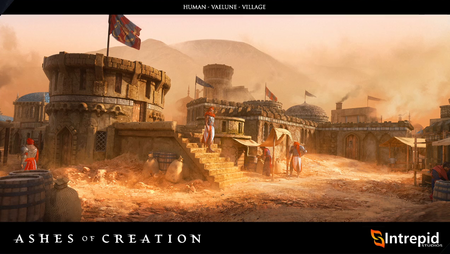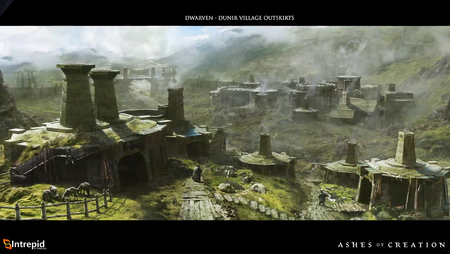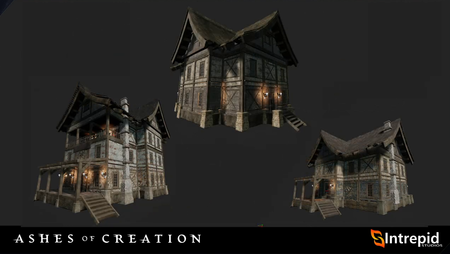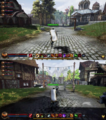Villages
A village is the third stage of node advancement.[4]
- At the Village Stage, the camp becomes a small frontier town. There are some permanent structures in place at this level, as well as the beginning of local Government. The Development Area feels permanent and lived in. You'll find buildings developed with more advanced materials, features such as stone and mortar, fences, and other common structures. The Village Stage will also unlock a Special Building that grants unique utility to its Node Type - Military, Economic, Divine or Scientific; we’ll share further details on those buildings in future entries in this series that cover each specific Node Type.[5] – Margaret Krohn
Node fejlődés
Nodes advance by collecting experience from the actions of players nearby. As players complete content inside of a Node’s Zone of Influence (the area around the node), they contribute that experience toward the Node’s development. The experience given to the Node may then be modified based on certain Events and Accomplishments. When a Node reaches the experience required, it undergoes the process of advancing to the next stage. There are a few exceptions where a Node cannot advance even though it has the required experience - most commonly, a Node can not advance if a Node is a Vassal of another Node and would advance to the same stage as its Parent Node.[5] – Margaret Krohn
A lakosok, és nem lakosok aktivitása (küldetések, gyűjtögetés, Raid-elés, stb.) a Node ZOI-ján belül annak a Node-nak a fejlesztését gyarapítja (fejlődés).[6] A Node-ok hét (7) fejlődési fázissal rendelkeznek, melyek mindegyikéhez hozzá van rendelve egy elérendő tapasztalatküszöb, a fejlesztéshez.[7]
| Node fázis.[6] | Alternatív név.[8] | Fejlesztéshez szükséges idő.[6] | Játékos lakások.[9] | |
|---|---|---|---|---|
| 0. | Vadon | - | ||
| 1. | Expedíció | Kereszteződés | Pár óra | - |
| 2. | Táborhely | Tábor | Órák | - |
| 3. | Falu | - | Pár nap | Kis házak |
| 4. | Kis város | - | Napok | Közepes házak |
| 5. | Város | - | Pár hét | Nagy házak |
| 6. | Metropolisz | Nagyváros | Hetek | Kastélyok |
The Development Area of a Node is where civilization will appear as the Node advances. As the Node Stage increases, different buildings, NPCs, and services will become available in the Development Area. The higher the Node Stage, the more complex and populated the Development Area becomes. Development Areas will also vary depending on the Node Type - Economic, Military, Scientific, or Divine; we’ll go into further details on each of those Node Types in future posts in this series.[5] – Margaret Krohn
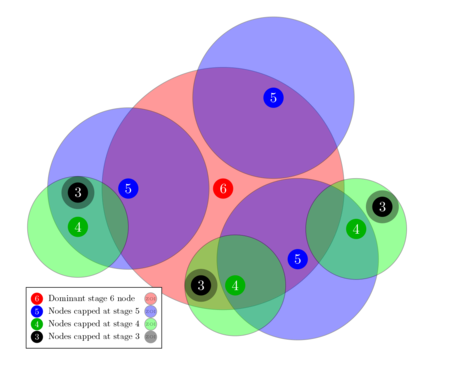
Beginning at Node Stage 3, when a Node advances, it enslaves nearby Nodes and makes them into its Vassals. Vassal Nodes are owned by a Parent Node and must always be at least one Node Stage below the Parent Node. This means that the Vassal Node cannot grow until the Parent Node advances in stage. Vassal Nodes give excess experience to their Parent Node, and are able to have their own Vassals, as long as they fit within the Parent Node’s Zone of Influence. They are subject to the government, alliances, wars, taxes, and trade of their Parent Node, and are able to receive federal aid from them. A Vassal Node cannot declare war on their Parent Node or any of its Vassals. Citizens of Vassals are bound by the diplomatic states of the Parent Node.[7] – Margaret Krohn
Egy Node fejlesztése elérhetővé teszi az egyedi tartalmát, amivel egyidejűleg egyre nagyobb körzetben akadályozza meg a szomszédos Node-ok fejlődését.[11]
- A Node-ok gyorsan érik el az első szintet. Ez elérhetővé teszi az NPC szolgáltatásokat, mint a bolt, vagy tárgyak eltárolása.[12]
- Minél fejlettebb egy Node, annál nagyobb a hozzá tartozó ZOI.[4]
- Kevésbé fejlett Node-ok (avagy vazallus Node-ok) amik fejlettebb Node ZOI-ján belül vannak, szerezhetnek további tapasztalatot, de nem fejlődhetnek a domináns Node szintjére.[10]
- A vazallus rendszer akkor lép életbe, ha egy Node eléri a 3.fázist (Falu), de a szomszédos, hármasnál kisebb Node-ok is megakadályozzák a közvetlen szomszédaik fejlődését.[13]
- A terület kiterjesztő algoritmus figyelembe veszi a legközelebbi tengerpartot, a szomszédos Node-okat és a környezetében lévő területek játékos-sűrűségét az elmúlt hetekben.[14]
- Azon okból, ahogy a kiterjeszkedést számító algoritmus kiszámolja egy növekedő Node ZOI-ját, előfordulhat, hogy két azonos szintű Node egymáshoz közel esik.[15]
The way that the algorithm expands the territories takes into account a few things: One it takes into account the coast like where's the closest coast. Two it takes into account the neighboring nodes so it can take over and essentially vassal state those nodes, but what's more important is essentially the initial population based on like how players choose their races. Because we have nine different races and four different starting points that branch out, each server's population density is going to dictate essentially the first few nodes that are that are highly populated and then that initial seed is what's going to determine the node structure as it moves inland into the into the world essentially; and based on the performance and successes of different sieges will determine which nodes that got locked out from the previous the initial advancements what nodes can now be available to advance further. So I really think that with so many variables that are present in the equation of how nodes advance and stay existing with the more variables you have, the higher likelihood there is for there to be a significant diversion in world progression.[14] – Steven Sharif
Normally the algorithm that's applied to the node territorial expansion will prevent significant nodes from being in close proximity to each other... There could be a perfect storm where all of the algorithmic progression of territory leads to having these nodes very close to each other because there's certain requirements that should that need to be available to satisfy node vassal takeovers; and it's possible that two nodes would never take each other over as vassals and end up close together and spanning their territories in opposite directions: The Tale of Two Cities thing.[15] – Steven Sharif
- A domináns Node nem kap tapasztalatot a vazallus Node-ok területén szerzet tapasztalatból, amíg azok el nem érik a számukra elérhető legnagyobb szintet.[10]
- A játékosok mozgatva(elteleportálva) lesznek, ha a fejlődés közben egy megjelenni készülő épület útjában vannak.[16]
- Egy Node lakosai gyarapíthatják egy eltérő Node fejlesztését.[17]
- A fejlődés konkrét tapasztalat követelménye (pl. hány szörnyet kell megölni) nem lesz nyilvánosan tudott, a rendszer kihasználását elkerülendő.[18]
Different people have different resources invested in nodes progressing and it would be a little "gamey" if you could know exactly what was necessary at that point because that would disincentivize people from participating.[18] – Steven Sharif
Vassal nodes
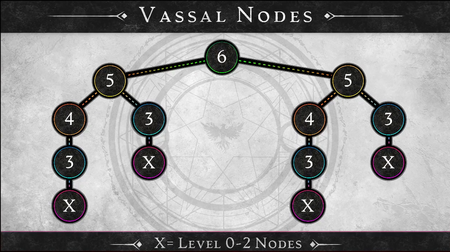
This vassal mode structure tells you what it looks like for a sovereign at a level six metropolis stage; and what it can control at a maximum vassal network is two level five nodes, of which a level five node can control one level four and one level three as direct vassals; and then the four can control a three; and every three can control a one or a two. Now if the three gets removed through siege, the one or the two is removed as well. So that's an important distinction between the three's vassals, which technically isn't really a vassal relationship because there's no citizenships possible. Those vassals don't exist between three and X, but they do exist between four and three, five and four, and six and five. And what this also allows is that because there are 85 nodes that are within the world, we have a buffer zone of about 20 nodes that lives in a max server state. So if you had maximum five metropolises form in a world, you will have a number about 20 nodes that can live alongside those metropolis networks; and when or if a metropolis falls, that extra cushion of nodes around the five metropolis structures allows for the map to be redistricted in a way that is unique. It doesn't mean that one of the fives is just going to pick up where the last six left off and form the same exact metropolis structure. From a territory perspective it has ancillary nodes to play with and expand towards that redistricts the map, so that if a metropolis falls there's a significant difference in the layout of the world and the layout of these almost nation-like territories.[19] – Steven Sharif
Village (stage 3) or higher nodes enslave nearby nodes, converting them into vassal nodes.[7][13]
- A Metropolis (színpad 6) can control up to two City (színpad 5) nodes. A City (színpad 5) can control one Town (színpad 4) and one Village (színpad 3) node. A Village (színpad 3) can control an Encampment (színpad 2) or an Expedition (színpad 1). If the Village (színpad 3) gets destroyed through a siege, its dependant Encampment (színpad 2) and Expedition (színpad 1) nodes are also destroyed.[19]
- There is a layer of intricacy between how the neighboring nodes advance and what potential parent structure they have in the vassalship tree.[20] – Steven Sharif
- Vassal nodes gain benefits from their regent node (also referred to as sovereign node or parent node) even if the node type of the parent is different to the vassal.[21][22]
- It is not a bad thing to be vasseled, it is a good thing to be vasseled. It brings many benefits from the Sovereign, which is the ultimate parent of that vassal network down to the vassal node itself; and it allows that vassal node to even live outside of its normal mechanics. You get to adopt some of the benefits that the node type of your sovereign is, even if your node type as a vassal node isn't the same.[22] – Steven Sharif
- Regent nodes collect taxes from their vassal nodes. These taxes cannot be taken by the mayor or other players.[24]
- Vassal nodes must remain at least one node stage below their parent node.[7]
- Neighboring/Adjacent nodes from Expedition (színpad 1) upward block the growth of their immediate neighbors. This was intended to be tested in Alpha-1.[25][13]
- Vassal nodes first apply any experience earned to their own deficit (see Node bomlás). It then applies excess experience earned to its parent node.[5]
- If the parent node advances, the vassal is once again able to advance.[7]
- Vassal nodes give excess experience to their parent node and may have their own vassals; so long as they fall within the parent node’s zone of influence.[24][7]
- If a node is capped and is both a vassal and has its own vassals, any experience earned from itself or its Vassals is first applied to its own deficit. Experience beyond that is then sent to its parent node.[5]
- When the vassal reaches its cap it overflows experience up to the parent; and so it can be very good early on for parents to get vassal nodes that are very productive- that have a lot of traffic.[24] – Steven Sharif
- Vassals are subject to the government, alliances, wars, taxes, and trade of their parent node, and are able to receive federal aid from them.[7]
- Vassal nodes cannot declare war on their parent node or any of their vassals.[7]
- Citizens of vassals are bound by the diplomatic states of the parent node.[7]
- If a Node is a Vassal Node and is capped from advancing further, it first applies any experience earned to its own deficit (see Node Atrophy section), and then applies excess experience earned to its Parent Node. If the Parent Node advances and the Vassal is able to grow, it becomes uncapped. If a Node is capped and is both a Vassal and has its own Vassals, any experience earned from itself or its Vassals is first applied to their own deficit. Any experience beyond that is then sent to its Parent Node.[5] – Margaret Krohn
Node elections
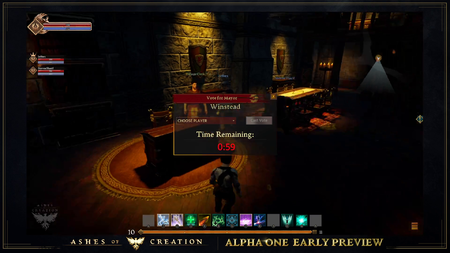
The village stage is a unique stage because that's when the government system comes online and all other stages past village there will have already been a cadence for the election system and it will follow that cadence, but after the initial village stage is completed there will be a one week period where players have an opportunity to establish citizenship at the village that also provides for the cooldown time that is- that would be present on players leaving another node to participate in in this particular node leveling up. But that after that one week period then there will be a one-week election process and then from that point moving forward will be the one month cadence that the node experiences elections on.[27] – Steven Sharif
Once a node has reached Village (színpad 3) there will be a one week cooldown period before node elections begin.[27]
- This cooldown period allows players to establish citizenship at the village; which may require them to relinquish previous citizenship at another node.[27]
- Following the initial cooldown, there will be a one week election process, then from that point on, elections will follow a monthly cadence.[27]
- Node ostromok may not be declared for 21 days following a node advancing to any stage.[28]
Node elections occur on a monthly basis.[27][30]
- Election notices will be mailed to the accounts of citizens.[31]
- Only citizens of a node may participate in its elections.[32]
- Only node citizens may be elected mayor.[33]
- A king or queen can also become a mayor.[33]
Buildings
Buildings within Ashes of Creation offer goods and services as well as player housing, either within nodes or on freeholds.[4]
- Node buildings are either default buildings that come with the node, or they are constructed buildings that are initiated by the mayor and built by players.[37][38][39][40][41][42][43]
- Freehold buildings that are placed on freehold plots function as homesteads, artisan and businesses buildings.[44][45][46][4][47]
Player housing
| Player housing | Type. | Availability. | Starting count. | Limit. |
|---|---|---|---|---|
| Apartmanok | Instanced.[4] | Village stage and higher.[48] | 50.[49] | One per character per server.[50] |
| Freeholds | Open world.[4] | Village stage and higher.[4] | Low thousands per server.[44][51] | One per account.[50] |
| Inns | Instanced.[52] | Starting areas and Node-ok.[53] | Most accessible.[53] | - |
| Static housing | In-node.[4] | Village stage and higher.[4] | 8.[49] | One per character per server.[50] |
- If you were to think about the level of exclusivity between the different types of housing that we have, obviously the most exclusive when it comes to a quantity is going to be Freeholds, followed by In-node housing, followed by Apartments, then followed by Inns.[54] – Steven Sharif
Real estate
Players buy the deeds for housing from the node itself, or may buy and sell properties from other players.[55][56][57][32][4]
- The developers are considering an auction-based method for listing new properties that become available for purchase when a node advances.[58] Currently freeholds may be acquired via auction.[44][59][60][61][45][62]
- Housing will have a base price that scales with the number of citizens in the node.[63]
- There is no cap on the price of player-originated housing sales.[64]
- In-node housing will be at a premium, and is expected to be hotly contested.[4]
- The more apartments that have been purchased in a node, the higher the price scales.[65]
- Player housing that is destroyed during a node siege can no longer be sold.[66]
- Freehold plots may be purchased from and sold to other players,[55][67] or can be obtained via deeds issued by a Village (színpad 3) or higher node.[44][59][60][61][45][62][68][69]
- We're establishing a real estate market that players can invest in and then sell within the in-game economy, but also they are a resource that's subject to removal through the sieging system as well, so there's a bit of risk implied there but the idea is that this is something for players to strive for.[67] – Steven Sharif
- Housing ownership can default back to the node if the owner fails to pay their property taxes. A balance and penalties will be charged to the new purchaser of the home in the manner of a "foreclosure process".[63]
- Players will not be able to exceed their allotment of housing in the game.[73]
- Rental and leasing concepts are under consideration.[73]
Housing benefits
Player housing offers a number of benefits.[56][74]
- Ability to claim citizenship to a node.[75][76][32]
- Additional benefits are granted to home owners who are also citizens of that node.[64]
- Ability to place furniture and other decor items.[77][78][79]
- Houses will be empty when purchased. Players will need to place furnishings and decorations in them.[80]
- Each size of player-owned housing determines how many decor items can be placed in it.[56]
- Storage containers.[79][74]
Each different type of housing offers different additional benefits.[64]
- Apartment benefits include placement of pots to grow seeds and other functional furniture items.[81]
- Freehold benefits include the ability to place business and artisan buildings.[45][78][74]
- Static housing benefits include garden sections for farming special types of crops.[82][83][78]
- Players may grow crops in the garden sections of freeholds or static houses.[81][83][78][84]
- Crafting benches are available in freeholds and static houses but not apartments.[81][78][74]
- Prized items can be displayed within a house.[74]
- Eredmények and trophies may be displayed.[74]
- Social activities.[74]
- Housing may provide proximity based bonuses.[74]
Lakókocsik
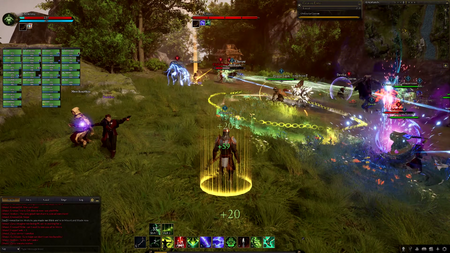
The Caravan System is a major aspect of the economy in Ashes of Creation. While the rewards can be great for moving massive amounts of Commodities and other materials across the world of Verra, players can choose to be Caravan attackers or defenders, making these hotspots for PvP battles.[86]
Lakókocsik are vehicles that facilitate the transfer of cargo across Verra.[88][89][90][91][92][93][94][95][96]
- Caravans are the induction of emergent gameplay, which means you cannot predict the situation you're going to be in when you use a caravan. That's part of the risk: The risk is the unknown. If you could predict it then your ability to mitigate that risk would unfortunately remove that dynamic- that ratio of risk versus reward.[97] – Steven Sharif
- Personal caravans are used to transport cargo for one or more players.[92][93][94]
- Mayoral caravans are used by Mayors to transfer cargo between nodes with established trade agreements or alliances.[90][91]
- Caravans are initiated from and arrive at caravansary node buildings within Village (színpad 3) nodes and above.[98][92][99][100]
- Lakókocsik create an objective-based PvP event in the open-world that players can choose to attack, defend, or opt-out of.[101][102][103][104]
- PvE caravan events can cause roadways to be blocked off or hostile mobs to spawn to attack the caravan.[105][106]
- It is possible to launch decoy caravans and merchant ships, but there are visual hints of what is contained in a caravan.[107][108][109] Decoy crates may be available via social organization progression.[107]
Node ostromok
As some areas in the world grow, others will fall. This is the foundation of the living, breathing world that is Ashes of Creation, where players will have the ability to make important decisions that matter in the longevity of an area becoming a city, or whether to siege a rival town. Rise above the ashes, create the world around you, and be a part of the story that unfolds because of your actions and decisions.[5] – Margaret Krohn
A Node ostrom lehetővé teszi egy Node rombolását.[5] Ez megnyitja a környező Node-ok fejlesztési lehetőségeit, ezzel korábban elzárt tartalomhoz is hozzáférést biztosítva. Ennek köszönhetően, a politikai viszály komoly szerepet játszik a világ formálásában.[6]
Egy Node ostromlása nem lesz egyszerű feladat a támadók számára. A városok és a metropoliszok komoly védelmi előnnyel bírnak.[6]
If you own a home in a node and you don't want to see that home destroyed, you need to defend that city![111] – Steven Sharif
A Node-ok szintet veszíthetnek a Node bomlás során.[5]
Monster coin events
Legion monster coin events are common events that occur for Node-ok up to the Village stage. This might include a horde of zombies rolling across the countryside finding something or someone to feast on. Players who wish to keep their advancements will need to be vigilant.[112]
Elite monster coin events occur for nodes that exist between the Village and Metropolis stages. This level of event would include something along the lines of a dungeon level bosses and mobs coming into the world to pillage and destroy specific centers of activity.[112]
Vizuális
2023-09-21
Továbbiak
Hivatkozások
- ↑ X.com - What do you all think about the aesthetic of this Village Node?
- ↑ Élő adás, 2020-01-30 (1:07:50).
- ↑ Élő adás, 2019-11-22 (50:56).
- ↑ 4.00 4.01 4.02 4.03 4.04 4.05 4.06 4.07 4.08 4.09 4.10 Node series part II – the Metropolis.
- ↑ 5.0 5.1 5.2 5.3 5.4 5.5 5.6 5.7 5.8 Blog - Know Your Nodes - Advance and Destroy.
- ↑ 6.0 6.1 6.2 6.3 6.4 A reactive world - Nodes.
- ↑ 7.0 7.1 7.2 7.3 7.4 7.5 7.6 7.7 7.8 Blog - Know Your Nodes - The Basics.
- ↑ Élő adás, 2018-12-12 (14:48).
- ↑ Interjú, 2020-07-20 (3:45).
- ↑ 10.0 10.1 10.2 Élő adás, 2017-10-16 (50:20).
- ↑ Video, 2017-04-20 (0:02).
- ↑

- ↑ 13.0 13.1 13.2

- ↑ 14.0 14.1 Interjú, 2020-07-18 (10:04).
- ↑ 15.0 15.1 Interjú, 2020-07-08 (1:00:15).
- ↑ Élő adás, 2017-11-17 (55:27).
- ↑
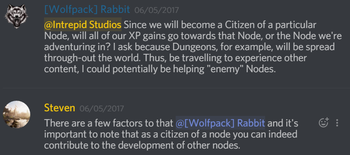
- ↑ 18.0 18.1 Élő adás, 2017-05-26 (28:16).
- ↑ 19.0 19.1 19.2 Élő adás, 2022-08-26 (1:07:34).
- ↑

- ↑ Élő adás, 2023-08-31 (52:56).
- ↑ 22.0 22.1 Élő adás, 2022-08-26 (1:04:35).
- ↑

- ↑ 24.0 24.1 24.2 Élő adás, 2022-08-26 (1:10:16).
- ↑

- ↑ Élő adás, 2020-03-28 (1:01:34).
- ↑ 27.0 27.1 27.2 27.3 27.4 Interjú, 2020-03-27 (6:03).
- ↑
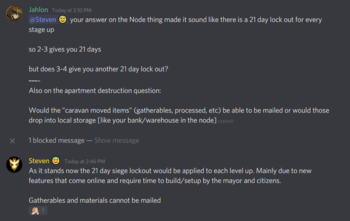
- ↑

- ↑

- ↑ Élő adás, 2020-10-30 (1:01:00).
- ↑ 32.0 32.1 32.2 MMOGames interview, January 2017
- ↑ 33.0 33.1 33.2

- ↑ Interjú, 2018-05-11 (50:05).
- ↑ Blog: Creative Director's Letter
- ↑ Élő adás, 2020-01-30 (1:01:59).
- ↑ Blog: Development Update with Village Node.
- ↑ Élő adás, 2023-08-31 (50:25).
- ↑ Video, 2023-08-31 (2:59).
- ↑ Interjú, 2023-07-09 (1:32:45).
- ↑ Élő adás, 2017-05-19 (33:57).
- ↑ Élő adás, 2018-01-20 (38:17).
- ↑ Élő adás, 2018-04-8 (PM) (51:49).
- ↑ 44.0 44.1 44.2 44.3 Blog: Exploring the Boundless Opportunities of Freeholds.
- ↑ 45.0 45.1 45.2 45.3 Development Update with Freehold Preview.
- ↑ Élő adás, 2023-04-07 (31:49).
- ↑ Élő adás, 2017-05-24 (9:58).
- ↑ Steven Sharif - Clarification points from today’s stream.
- ↑ 49.0 49.1

- ↑ 50.0 50.1 50.2 Interjú, 2018-05-11 (50:47).
- ↑

- ↑ Élő adás, 2023-08-31 (22:32).
- ↑ 53.0 53.1 Élő adás, 2023-08-31 (15:51).
- ↑ Élő adás, 2023-08-31 (18:13).
- ↑ 55.0 55.1

- ↑ 56.0 56.1 56.2 56.3 Élő adás, 2020-06-26 (47:32).
- ↑ Élő adás, 2020-06-26 (54:03).
- ↑ 58.0 58.1 58.2 58.3 Élő adás, 2017-05-12 (55:01).
- ↑ 59.0 59.1 Élő adás, 2023-06-30 (1:12:07).
- ↑ 60.0 60.1 Élő adás, 2023-06-30 (14:09).
- ↑ 61.0 61.1 Élő adás, 2023-06-30 (13:10).
- ↑ 62.0 62.1 Video, 2023-06-30 (21:22).
- ↑ 63.0 63.1 Élő adás, 2020-06-26 (53:41).
- ↑ 64.0 64.1 64.2 Interjú, 2020-07-08 (33:34).
- ↑ Élő adás, 2017-05-12 (52:01).
- ↑ Élő adás, 2020-06-26 (1:02:12).
- ↑ 67.0 67.1 Élő adás, 2023-06-30 (1:15:34).
- ↑

- ↑ Élő adás, 2017-05-19 (32:23).
- ↑

- ↑ Élő adás, 2020-06-26 (56:08).
- ↑ Élő adás, 2023-06-30 (1:20:20).
- ↑ 73.0 73.1 Élő adás, 2019-05-30 (1:23:41).
- ↑ 74.0 74.1 74.2 74.3 74.4 74.5 74.6 74.7 Élő adás, 2017-05-10 (30:53).
- ↑ Interjú, 2023-07-09 (38:14).
- ↑

- ↑ Interjú, 2020-07-08 (40:20).
- ↑ 78.0 78.1 78.2 78.3 78.4 Élő adás, 2020-06-26 (45:32).
- ↑ 79.0 79.1 79.2 79.3 Video, 2020-05-31 (47:32).
- ↑ Élő adás, 2020-06-26 (53:20).
- ↑ 81.0 81.1 81.2 Interjú, 2023-07-09 (41:22).
- ↑ Interjú, 2021-02-07 (42:41).
- ↑ 83.0 83.1 Élő adás, 2020-10-30 (44:22).
- ↑ Élő adás, 2017-05-05 (32:11).
- ↑ Video, 2024-01-31 (29:15).
- ↑ Newsletter - January 2024.
- ↑ Video, 2024-01-31 (5:22).
- ↑ Élő adás, 2023-10-31 (1:30:52).
- ↑ Élő adás, 2023-10-31 (1:06:32).
- ↑ 90.0 90.1 Élő adás, 2023-08-31 (2:10:23).
- ↑ 91.0 91.1 Video, 2019-07-15 (2:12).
- ↑ 92.0 92.1 92.2 Élő adás, 2022-08-26 (1:20:17).
- ↑ 93.0 93.1 Élő adás, 2022-07-29 (3:21).
- ↑ 94.0 94.1 Interjú, 2018-05-11 (28:21).
- ↑ Élő adás, 2017-05-15 (45:20).
- ↑ About Ashes of Creation.
- ↑ Élő adás, 2024-01-31 (57:26).
- ↑ Video, 2023-10-31 (10:13).
- ↑ Élő adás, 2020-05-29 (46:36).
- ↑ Élő adás, 2017-07-28 (20:56).
- ↑ Interjú, 2020-03-27 (16:19).
- ↑

- ↑ Élő adás, 2017-05-22 (40:40).
- ↑

- ↑ Video, 2023-10-31 (34:12).
- ↑ Podcast, 2021-04-11 (23:36).
- ↑ 107.0 107.1 Élő adás, 2024-01-31 (1:15:05).
- ↑ Video, 2023-10-31 (29:36).
- ↑ Élő adás, 2021-01-29 (1:25:14).
- ↑ Video, 2016-12-04 (0:02).
- ↑ Video, 2017-04-30 (5:31).
- ↑ 112.0 112.1 Élő adás, 2017-05-03 (36:25).
